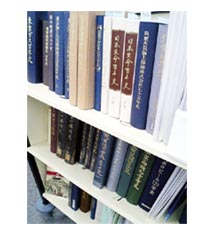|
|
 |
 |
 |

 |
 |
Publishing a shashi, or company history, is common practice for many Japanese companies. Individually a shashi is a rich resource on the origin and experiences of a particular company and collectively they show the trajectory of Japan’s modern economic development. Unfortunately, however, shashi are not easily accessible at present, for they are mostly in-house publications with a limited circulation.
This ambitious project envisions the creation of a comprehensive database of shashi to facilitate access to the information they contain. The database will be available online when completed. Ms. Katsuko Murahashi, a shashi expert, is the leader of this project.
|
|
 |
|
 |

Shashi is a general Japanese term for the history of a company, but it is usually used to refer to published volumes of company history.
Our shashi expert Ms. Murahashi defines shashi as publications in which a company provides an account of its own history based on its own archives. According to Murahashi, more than 13,000 shashi were published between the end of the 19th century and 2002. Today more than 100 are published every year.
Terms such as kaisha-shi (company history) or nenshi (year history) are often used interchangeably with shashi. Shashi and kaisha-shi refer exclusively to company history, however, while the term nenshi is broader and can include not only published histories of business enterprises, but also those of other organizations such as schools, municipalities, religious bodies, etc. |
| [ back to top ] |
 |

Shashi can be characterized as grey literature as they are in-house publications and the target readers are usually limited to employees and people associated with the company. Distribution tends to be very limited and dependent on private channels.
The bibliographic information provided in shashi can often be inconsistent. For example, titles printed on the title page, the colophon, and the cover are not always identical. This is simply because shashi are edited by non-specialized editors and published by non-professional publishers. Editorial responsibility often rests with a company’s editorial board and in most cases the publisher is the company itself. |
| [ back to top ] |
 |

Useful Works on Shashi:
Matsuzaki, Yuko. "The Shibusawa Shashi Project and Sharing Information on Business Archives in Japan," Business Archives, Principles and Practice, No. 91, May 2006. pp. 28-43.
Murahashi, Katsuko. Shashi no kenkyu (A Study of Published Company Histories). Tokyo: Diamond, Inc., 2002.

Zoho kaiteiban kaishashi sogo mokuroku (A Supplemented and Revised Union Catalogue of Histories of Companies and Economic Organizations). Tokyo: Japan Business History Institute, 1996.

Nihon kaishashi soran (A Comprehensive Bibliography on Japanese Company Histories). 3 vols. Tokyo: Toyo Keizai Inc., 1995.

Links to shashi publications |
| [ back to top ] |
|
|